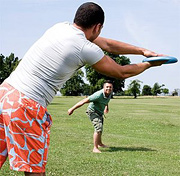To Your Health
July, 2007 (Vol. 01, Issue 07) |
|
|
Summer Spinal Safety
Stay in the Game
By Dr. Kevin M. Wong
Summer sports are a favorite pastime of beachgoers and sun lovers everywhere. From bicycle riding and swimming to football, baseball and volleyball, outdoor activities can put a great deal of strain on your spine. Find out what your body needs to stay in the game.
As we move into the summer months, the weather has become more inviting, and many of you will begin or increase your outdoor activities. Some of you may decide to revisit exercise routines or sporting activities that you abandoned during the colder winter months. For others, you may be increasing your activity level since it feels so wonderful to be outside. I applaud you for being proactive about your health.
There are a multitude of activities that become more prevalent during these months, including tennis, bike riding, water sports, hiking and beach-related sports, to name a few. Whatever activity you choose, make sure you protect your body and use sound judgment so you don't put yourself at risk for injury.
Your body is an amazing thing. When your spine, bones, joints, muscles, tendons and ligaments are all working well, you take no notice that your body is doing what it is supposed to. However, when your body is stressed or damaged, either from a single injury or over time, it starts letting you know. You may feel tight muscles, stiffness, a reduced ability to move comfortably, and even pain. These signs should not be covered up with medication. That's like taking the batteries out of a smoke detector during a fire.
We have an important responsibility to make sure we listen to our own bodies. By taking the time to make sure our bodies are safe when we exercise, we can maintain our spinal function, along with the function of our muscles and connective tissue, and keep ourselves pain-free. Now that's prevention.
Start With a Warm-Up
 Before you participate in any activity, you should thoroughly warm up your back and your body. You should especially focus on warming up the muscles you will be using most in the sport you are playing. Start by increasing your heart rate gradually with simple movements, such as walking or jogging. Then stretch your neck, shoulder, arm, lower back, hamstring and calf muscles. Finally, start out slowly when you begin your activity.
Before you participate in any activity, you should thoroughly warm up your back and your body. You should especially focus on warming up the muscles you will be using most in the sport you are playing. Start by increasing your heart rate gradually with simple movements, such as walking or jogging. Then stretch your neck, shoulder, arm, lower back, hamstring and calf muscles. Finally, start out slowly when you begin your activity.
Your chiropractor is an expert at evaluating your body's structure. He or she can identify and correct any weaknesses or imbalances that could make you more susceptible to injuries. Your chiropractor also can provide you with a series of exercises to help improve your athletic performance.

